
(a)
Interpretation:
The complete, detailed mechanism and the major organic product for the given reaction is to be drawn.
Concept introduction:
When an
Answer to Problem 18.65P
The complete, detailed mechanism and the major organic product for the given reaction are shown below:
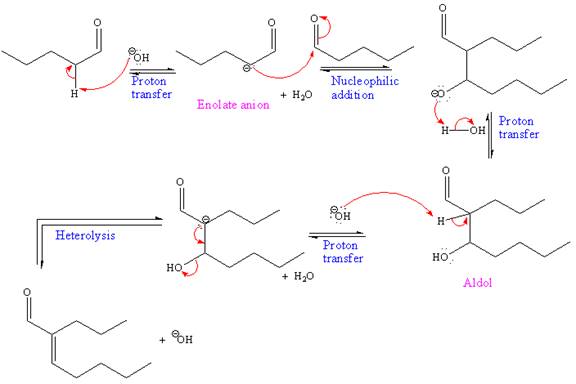
Explanation of Solution
The given reaction is as shown below:

The given reaction is aldol condensation as the sodium hydroxide and heat is given. Firstly, the given aldehyde is treated with sodium hydroxide to produce
The complete, detailed mechanism and the major organic product for the given reaction are shown below:
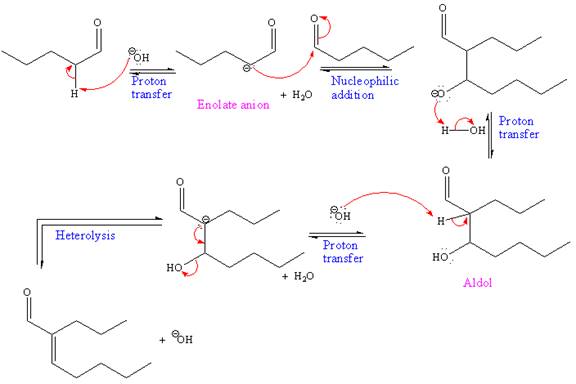
The complete, detailed mechanism and the major organic product for the given reaction are drawn by aldol addition reaction, followed by E1cb mechanism.
(b)
Interpretation:
The complete, detailed mechanism and the major organic product for the given reaction are to be drawn.
Concept introduction:
When an aldehyde is treated with sodium hydroxide, the product
Answer to Problem 18.65P
The complete, detailed mechanism and the major organic product for the given reaction are as shown below:
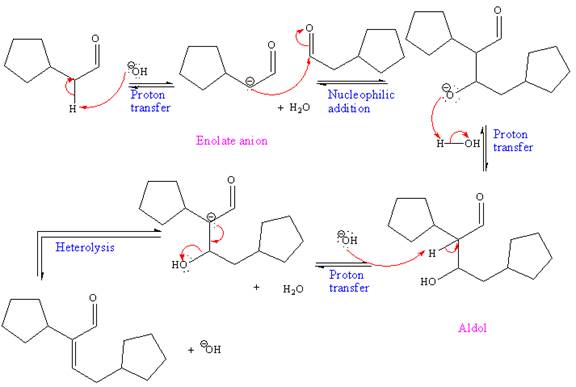
Explanation of Solution
The given reaction is shown below:

The given reaction is aldol condensation as the sodium hydroxide and heat is given. Firstly, the given aldehyde is treated with sodium hydroxide to produce
The complete, detailed mechanism and the major organic product for the given reaction are shown below:
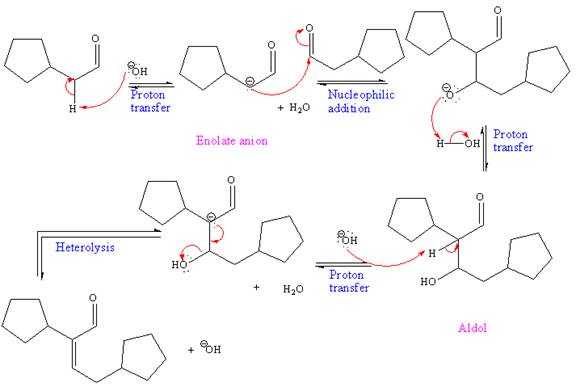
The complete, detailed mechanism and the major organic product for the given reaction are drawn by aldol addition reaction followed by E1cb mechanism.
(c)
Interpretation:
The complete, detailed mechanism and the major organic product for the given reaction is to be drawn.
Concept introduction:
When an aldehyde is treated with sodium hydroxide, the product
Answer to Problem 18.65P
The complete, detailed mechanism and the major organic product for the given reaction are as shown below:

Explanation of Solution
The given reaction is shown below:

The given reaction is aldol addition as the sodium hydroxide is given. The given aldehyde is treated with sodium hydroxide to produce
The complete, detailed mechanism and the major organic product for the given reaction are shown below:

The complete, detailed mechanism and the major organic product for the given reaction are drawn by intramolecular aldol addition reaction mechanism.
(d)
Interpretation:
The complete, detailed mechanism and the major organic product for the given reaction are to be drawn.
Concept introduction:
When aldehyde is treated with sodium hydroxide, the product
Answer to Problem 18.65P
The complete, detailed mechanism and the major organic product for the given reaction are as shown below:
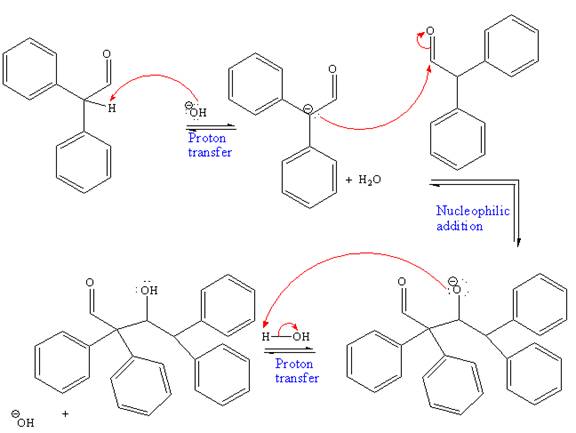
Explanation of Solution
The given reaction is shown below:
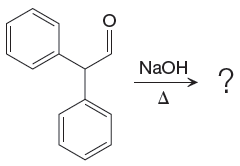
The given reaction is aldol condensation as the sodium hydroxide and heat is given. Firstly, the given aldehyde is treated with sodium hydroxide, to produce
The complete, detailed mechanism and the major organic product for given reaction are shown below:

The complete, detailed mechanism and the major organic product for given reaction are drawn on the basis of aldol addition reaction mechanism.
Want to see more full solutions like this?
Chapter 18 Solutions
ORGANIC CHEMISTRY E-BOOK W/SMARTWORK5
- Draw the complete, detailed mechanism for the reaction shown here. Will the product be optically active? Explain.arrow_forwardDraw the complete, detailed mechanism for the following reaction.arrow_forward(SYN) Show how to synthesize the following molecule from any compounds containing two carbons. Draw the complete, detailed mechanism for the reaction.arrow_forward
- Draw a complete, detailed mechanism for the reaction shown here.arrow_forwardPredict the major products of the following reactions. Draw the complete, detailed mechanism that leads to the formation of each of those products.arrow_forwardDetermine the major product of each reaction in Problem and draw the complete, detailed mechanism. Pay attention to stereochemistry where appropriate.arrow_forward
- Please draw the complete, detailed mechanism of the reaction step by step.arrow_forwardHelp, explain in detail please. Thank you! Did the overal reaction shown here occur by and SN2, Sn1, E2, or E1 mechanism? How do you know? Draw the complete, detailed mechanism to account for the formation of both products.arrow_forwardDraw a complete, detailed mechanism for the following reaction. A key intermediate is provided.arrow_forward
 ChemistryChemistryISBN:9781305957404Author:Steven S. Zumdahl, Susan A. Zumdahl, Donald J. DeCostePublisher:Cengage Learning
ChemistryChemistryISBN:9781305957404Author:Steven S. Zumdahl, Susan A. Zumdahl, Donald J. DeCostePublisher:Cengage Learning ChemistryChemistryISBN:9781259911156Author:Raymond Chang Dr., Jason Overby ProfessorPublisher:McGraw-Hill Education
ChemistryChemistryISBN:9781259911156Author:Raymond Chang Dr., Jason Overby ProfessorPublisher:McGraw-Hill Education Principles of Instrumental AnalysisChemistryISBN:9781305577213Author:Douglas A. Skoog, F. James Holler, Stanley R. CrouchPublisher:Cengage Learning
Principles of Instrumental AnalysisChemistryISBN:9781305577213Author:Douglas A. Skoog, F. James Holler, Stanley R. CrouchPublisher:Cengage Learning Organic ChemistryChemistryISBN:9780078021558Author:Janice Gorzynski Smith Dr.Publisher:McGraw-Hill Education
Organic ChemistryChemistryISBN:9780078021558Author:Janice Gorzynski Smith Dr.Publisher:McGraw-Hill Education Chemistry: Principles and ReactionsChemistryISBN:9781305079373Author:William L. Masterton, Cecile N. HurleyPublisher:Cengage Learning
Chemistry: Principles and ReactionsChemistryISBN:9781305079373Author:William L. Masterton, Cecile N. HurleyPublisher:Cengage Learning Elementary Principles of Chemical Processes, Bind...ChemistryISBN:9781118431221Author:Richard M. Felder, Ronald W. Rousseau, Lisa G. BullardPublisher:WILEY
Elementary Principles of Chemical Processes, Bind...ChemistryISBN:9781118431221Author:Richard M. Felder, Ronald W. Rousseau, Lisa G. BullardPublisher:WILEY





